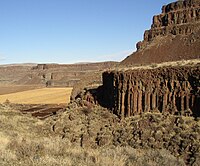
Photo from wikipedia
Formation and subsequent modification processes of lower crust play important roles in evolution and rheological models for continental lithosphere. In the last two decades, numerous xenolith studies have documented metasomatism… Click to show full abstract
Formation and subsequent modification processes of lower crust play important roles in evolution and rheological models for continental lithosphere. In the last two decades, numerous xenolith studies have documented metasomatism of continental mantle in the Rocky Mountain region of North America. However, much less attention has been paid to whether and to what extent these processes may have affected the crust. We address the nature and timing of hydrous alteration of extant deep Proterozoic crust in the Colorado Plateau through a petrological and geochronological study of a xenolith from the Red Mesa diatreme in the 30–20 Ma Navajo volcanic field. Fluid-related alteration is widespread in sample RM-21, with the main features recorded by breakdown effects in feldspar, garnet, and allanite, and the production of secondary assemblages characterized by lower Ca plagioclase (or albite) + muscovite + biotite + calcite + monazite + zoisite at estimated conditions of 0.8–0.7 GPa (or ∼27 km depth) and 480 °C. Th-Pb dating by ion probe reveals a period of monazite crystallization at 70–65 Ma, interpreted to reflect late alteration of the high-temperature metamorphic assemblage with hydrous fluid introduced by the shallowly subducting Farallon slab. Similar to previous suggestions involving mantle hydration, the growth of low-density hydrous phases at the expense of high-density, anhydrous minerals, which are abundant in unaltered Proterozoic crust, if sufficiently widespread, could have contributed to elevated topography in the Colorado Plateau and regionally across the Rocky Mountains and High Plains.
Journal Title: Lithosphere
Year Published: 2017
Link to full text (if available)
Share on Social Media: Sign Up to like & get
recommendations!